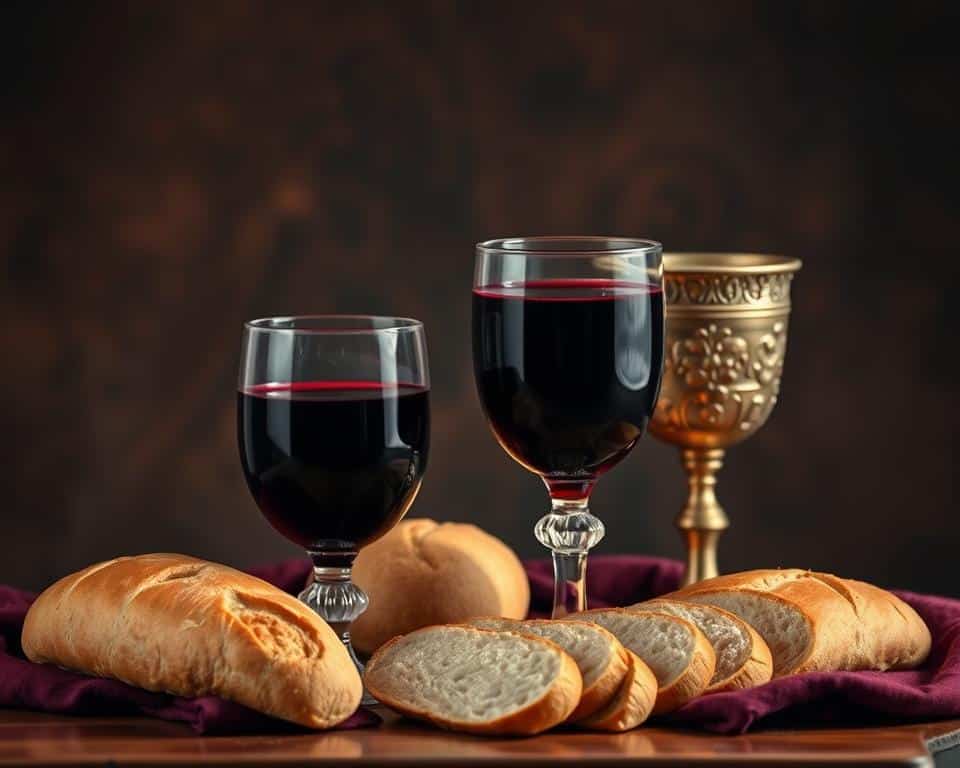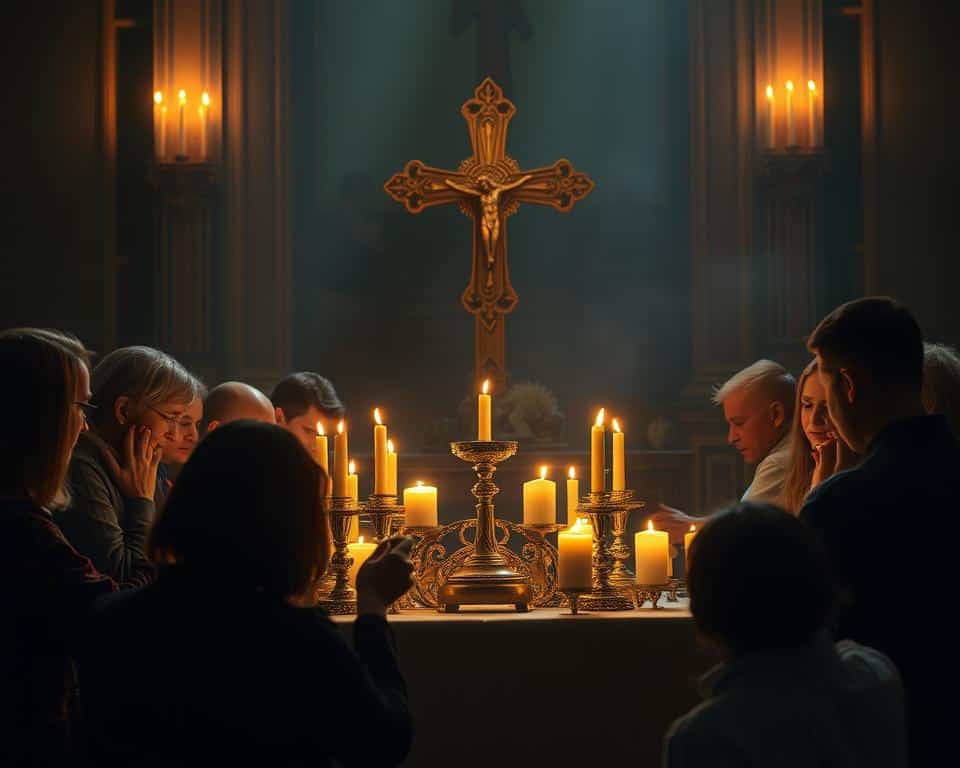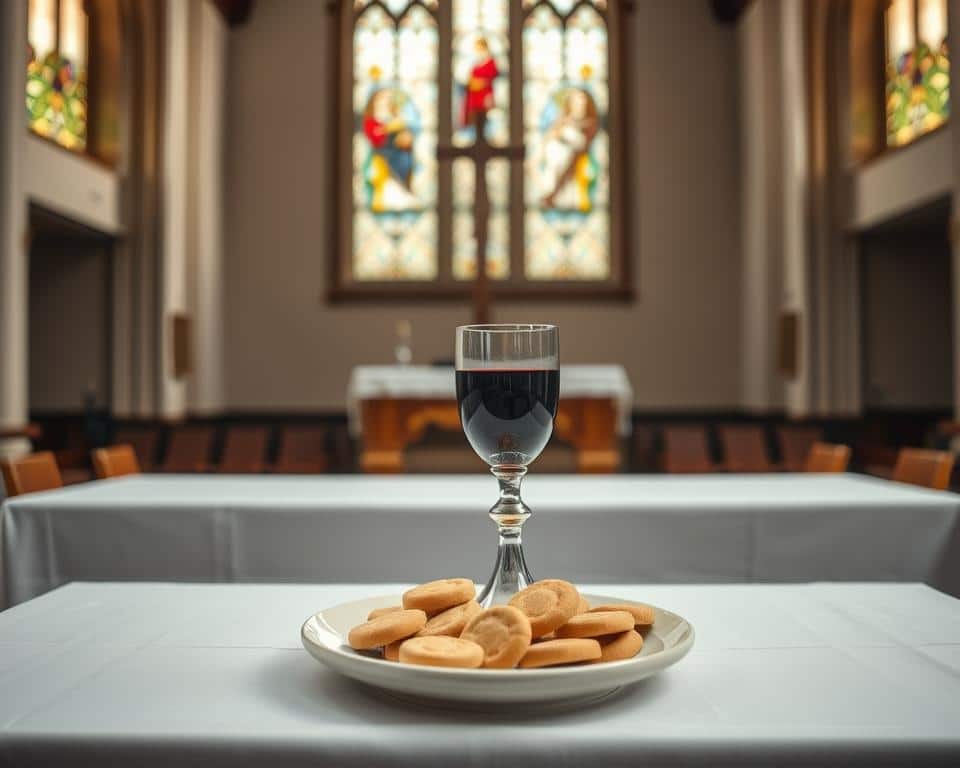“Do this in remembrance of me.” — Jesus’ words in Luke 22:19 capture the heart of this sacred practice. Communion isn’t just a ritual; it’s a powerful reminder of Christ’s sacrifice and the covenant He established with His followers.
When believers share the bread and wine, they honor Jesus’ body and blood, given for them. This act connects them to His death on the cross and His promise of grace. It’s a moment of unity, reflecting how the early disciples gathered in faith.
Rooted in Scripture, this practice invites you to reflect on God’s love. Whether through bread or wine, the message remains: Christ’s sacrifice brings hope. It’s not just tradition—it’s a living testament to His truth.
Communion Explained: The Meaning Behind the Sacrament
At the heart of the Lord’s Supper lies a deep connection to Jesus’ final meal with His disciples. This sacred act, often called holy communion, traces back to the Last Supper, where Jesus gave bread and wine a new purpose.

The Biblical Foundation
During the Last Supper, Jesus took bread, broke it, and said, “This is my body, given for you” (Luke 22:19). The wine symbolized His blood, shed for forgiveness. This mirrored Passover traditions, where unleavened bread and wine foreshadowed His sacrifice.
Hebrews 9:22 reminds us: “Without the shedding of blood, there is no forgiveness.” Jesus’ act fulfilled Old Testament sacrifices, offering eternal atonement.
Symbolism of Bread and Wine
The bread, unleavened and pure, reflects Christ’s sinless body. When you eat bread during holy communion, you remember His brokenness for you.
The wine signifies covenant renewal—a promise sealed with His blood. Paul’s warning in 1 Corinthians 11:27-29 urges reverence: partake thoughtfully, honoring the sacrifice.
- Origin: Instituted by Jesus at the Last Supper (Matthew 26:26-28).
- Connection: Passover’s matzoh and wine pointed to Christ.
- Warning: Unworthy participation disrespects the covenant.
Every time you share the Lord’s Supper, you proclaim His death until He returns. It’s more than ritual—it’s faith in action.
The Purpose of Communion in Christian Faith
Through the act of sharing bread and wine, believers connect deeply with Christ’s sacrifice. This practice isn’t just tradition—it’s a living response to His love. Every time you partake, you honor the purpose communion holds: remembering His death and celebrating new life.
Remembering Christ’s Sacrifice
The bread and wine point directly to Jesus’ body and blood. They remind you of His death on the cross, where He secured forgiveness sins for all who believe. As John Piper notes, this meal nourishes hope by drawing you into fellowship with Him.

Paul’s words in 1 Corinthians 11:26 ring true: “For whenever you eat this bread and drink this cup, you proclaim the Lord’s death until He comes.” This isn’t passive remembrance—it’s a proclamation of faith in His redeeming power.
Spiritual Unity Among Believers
When the church gathers, the shared elements symbolize equality. As 1 Corinthians 10:17 says, “We all share one bread, one body.” This unity transcends differences, binding followers together in God’s grace.
Practical preparation matters too. Before participating:
- Reflect on Christ’s sacrifice with gratitude.
- Confess anything hindering your relationship with Him.
- Approach the table with reverence, embracing its way of renewal.
Communion isn’t just about the past—it’s a promise. It points to His return and the eternal unity we’ll share.
How Different Christian Denominations Practice Communion
Across Christian traditions, the way churches celebrate this sacred meal varies widely. While all honor Christ’s sacrifice, methods reflect deep theological and cultural differences. Here’s how major groups approach it today.
Roman Catholic and Orthodox Traditions
Catholics believe in transubstantiation—the bread and wine become Christ’s actual body and blood. Before partaking, confession and fasting are required. The Orthodox Church shares this reverence but uses a spoon to distribute the elements, emphasizing unity through a common cup.
Both traditions uphold strict preparation. As one Orthodox priest notes, “We fast to prepare our hearts, not just our bodies.” This mirrors early church practices, where the meal was central to worship.
Protestant Variations and Open Communion
Many Protestant churches view the elements symbolically. Baptists often use grape juice and trays for individual servings, while Lutherans kneel, believing Christ is “in, with, and under” the bread and wine.
- Episcopalians blend formality with openness, inviting all baptized believers.
- Methodists practice open communion, seeing it as God’s gift to all people.
- Adventists emphasize reflection, often celebrating quarterly.
Whether through liturgy or simplicity, each tradition points to the same truth: Christ’s sacrifice unites believers across time and culture.
The Historical Roots of Communion
Jesus transformed an ancient Jewish tradition into a lasting memorial of His love. What began as Passover—celebrating deliverance from Egypt—became the new covenant through His sacrifice. When He took bread at the supper, He gave it eternal meaning.
The Last Supper and Its Significance
That final meal wasn’t random. Jesus chose Passover—when Jews remembered God saving them through lamb’s blood. As Luke 22:19 records, He declared: “This is my body given for you.” The wine symbolized His blood, sealing God’s promise.
This fulfilled Exodus’ story while starting something greater. The Passover lamb pointed to Christ’s death on the cross. Where Egypt’s bondage ended, sin’s power broke forever.
Evolution of Communion Practices Over Time
Early Christians gathered weekly in homes, sharing meals as Acts 2:42 describes. By 300 AD, formal church buildings emerged, and clergy began overseeing the ritual. Medieval debates focused on Christ’s presence in the elements.
The Reformation brought change:
- Luther kept liturgy but emphasized faith’s role
- Calvin taught spiritual nourishment through the meal
- Anabaptists simplified it as a memorial
Today, despite differences, all agree on essentials. The bread and wine still point to Christ’s sacrifice. As one pastor notes: “The table unites us across centuries—same Savior, same grace.”
Modern churches continue adapting. Some use gluten-free bread or juice for health needs. Others project lyrics for sung responses. Yet the core remains unchanged—remembering Jesus’ words at that final supper.
Practical Aspects of Celebrating Communion
Preparing for the Lord’s Supper involves thoughtful steps to honor its sacred meaning. From selecting the elements to arranging the table, each detail reflects reverence for Christ’s sacrifice. Here’s how to approach this practice with care.
Preparing the Elements and Setting the Table
Choose unleavened bread or wafers, symbolizing Christ’s sinless body. Some church traditions use grape juice instead of wine, especially where alcohol is avoided. The cup and bread should be placed on a clean cloth, often beside a cross or candles to focus hearts on worship.
Denominations vary in their practices:
- Catholics fast for one hour before receiving.
- Orthodox avoid gum or food after partaking.
- Baptists pass trays with individual cups.
- Lutherans kneel at altar rails for the meal.
Guidelines for Receiving Communion
Approach the table with humility. Reflect on 1 Corinthians 11:28: “Everyone ought to examine themselves before they eat.” Confess anything that hinders your relationship with Christ, and thank Him for His sacrifice.
Many church groups today encourage quiet reflection or kneeling. Handle the elements carefully—they represent Jesus’ body and blood. Whether you drink grape juice or wine, remember the power of His covenant. This way, you honor the meal’s true purpose.
Deepening Your Faith Through Communion
This sacred meal invites you to grow closer to Christ. As you partake, reflect on His grace and the covenant sealed at the supper. John Piper reminds us: “Feast on the benefits of His death.” Let this moment renew your commitment to Him.
Before taking communion, examine your heart. Paul’s warning in 1 Corinthians 11:27 urges reverence. Pair this practice with prayer or journaling for deeper remembrance of His sacrifice.
Regular observance strengthens your faith. It’s not just a ritual—it’s a call to live differently. Forgive others. Serve with love. Let Christ’s life in you transform daily actions.
One day, He will return. Until then, this meal points to hope. Every time you share the bread and cup, you proclaim His victory over sins and the promise of eternal joy.
FAQ
What does the bread and wine symbolize in the Lord’s Supper?
The bread represents Christ’s body, broken for you. The wine (or grape juice) signifies His blood, shed for the forgiveness of sins. Together, they remind us of His sacrifice and the new covenant.
How often should believers take part in this sacred practice?
Scripture doesn’t specify a set frequency. Many churches observe it monthly or quarterly, but the focus should always be on heartfelt remembrance, not routine.
Can children or non-members participate in the service?
This varies by church tradition. Some encourage all followers of Christ to join, while others reserve it for baptized members. It’s best to follow your church’s guidance.
Why do some churches use grape juice instead of wine?
Many faith communities, including Seventh-day Adventists, choose unfermented juice to honor temperance principles while keeping the symbol’s meaning intact.
What’s the difference between closed and open communion?
Closed communion restricts participation to members of that denomination. Open communion invites all believers in Christ to partake, emphasizing unity in faith.
How can I prepare my heart before taking part?
Reflect on Christ’s sacrifice, confess any known sins, and pray for a renewed commitment to follow Him. It’s a time for gratitude and self-examination.





